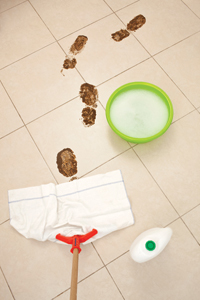
|
Ever wonder why the most irritated people always call you? Actually, it could have less to do with you than it does with the kind of contracting business you’re in. (Plus, there’s actually good news in the call, which we’ll cover in a moment.)
Let’s be clear: Plumbers get irritated callers because that person is usually very wet or very dry. Usually an untimely breakdown has happened in the caller’s plumbing world, and his panic button has been pushed.
From this point, the service you provide can either soothe or increase these feelings of panic and irritation. A better understanding of common complaints can help.
But more bad news first …
Human nature reveals that a customer whose standard expectation was “achieved” gives zero word-of-mouth recommendations. (Keep this in mind when you’re trying to merely satisfy the customer or only provide service comparable to the average. It’s getting you nowhere.)
Those who “exceed” expectations are generally mentioned four to seven times in 30 days. (It falls off dramatically after that, which is why you should stay in touch beyond the 30-day mark.) This can create a separate stream of positive referrals.
Make it easy for you to stay in touch. Capture the customer’s email address. Have him like your business on Facebook, Twitter, Google+ or other social media platforms. But remember, no one likes to be constantly spammed or to see his plumber’s swimsuit pictures on his newsfeed. So keep the contact professional and timely.
Send customers follow-ups or reminders through email and post useful home care, how to’s or health tips on your social sites. Keep selling to a minimum; these are strictly to inform and entertain the homeowners.
Just imagine the damage of not keeping in touch might be causing you every month. Forget imagination: If you commit any of the items on this list, it is costing you.
Five reasons customers don’t like you
You’d be wise to know the top reasons customers do not like or recommend contractors to others. Any reduction or elimination of the following can add thousands of dollars and hundreds of customers to your company, usually for little or no money.
1. Not scheduling the appointment fast enough. Put yourself in the customer’s sometimes-soggy shoes. Maybe he’s looking at funky brown drinking water and calls only to hear you might get there a week from Tuesday. The fact is that if you can’t provide quick relief, your customer will find it elsewhere. Sorry, nature of the business.
I realize you may have scheduling issues in a busy season. But you must educate customers and offer assurance on what you can do to alleviate their problem. (A CSR training course can work wonders.) Give a specific time and keep it.
Powerful Technique:Contractor clients have gotten great results with emergency solutions that lock in the customer. From the earlier example, you’d leave behind a company-logoed dispenser of safe drinking water, resolving the immediate issue. This buys you time to assess and find a more permanent resolution. But you may not get to solve anyone’s problem if you commit this next error …
2. Not showing up on time or at all. Chances are, you’ve got a customer who left work to sit in his drippy home and wait for you. The longer he waits past the appointment window, the more irritated he gets. And since techs aren’t often trained in social graces, you’ve got a recipe for a negative relationship from the start. (Notice I didn’t say “job.” I said “relationship,” a powerful distinction.) And if you don’t show up at all, this ex-customer will likely be in strangulation mode if he calls again. No matter, his friends and neighbors will get all the updates they can stand. Three options: Either keep the appointment, keep the customer informed or lose the customer.
Powerful Technique:The confirmation call. It takes about two minutes to confirm the appointment and/or reschedule if you’re running behind. No one expects you to be 100% punctual but this is a dramatic improvement beyond the currently low expectations. If the appointment window will be delayed more than one hour, give the customer the option to reschedule. This brings to mind another no-no …
3. Not finishing on time. Your customer perceives that slowness or dawdling is costing him money (a nonissue with flat-rate) but it still reeks of inefficiency. I recommend abbreviated rapport-building, get to your work, get it done. Then go over the invoice, offer options and upsells to maximize time. Customers want the problem solved and — at that moment — are most receptive to avoiding the problem in the future.
Powerful Technique:Maintenance agreement programs are very attractive if packaged as time- and money-savers. This is the No. 1 upsell (takes two to six sentences to close) and can guarantee future sales, referrals, faster sales cycles and better relationships.
Yet, this option will likely go poorly if you’re clumsy or are perceived as …
4. Breaking their stuff. Who hasn’t taken their car into the shop with noise A and left — after paying — with noise B? This perception also pervades home services. Yet, often with plumbing, it’s more than coincidence. For example, if a plumber fixes a low water pressure problem, it may seem as if the drains are much slower. Likely they were slow to begin with. A great plumber will note this before he starts, helping eliminate the perception and opening the door to an upsell.
Powerful Technique:The pre-sell mentioned above is good, along with a list of related problems on a Green Sheet. This is handed to your customer at the beginning of the call, introducing services, expectations and differences with your company. It’s a marketing message and an educational piece that, for example, relates low pressure to disintegrating pipe which helps eliminate “surprise” stories from homeowners.
However, if you’re regularly putting your size 13s through Sheetrock or backing over the begonias and letting the dog out, you’ve got a discipline problem. Just ask your wife.
5. Not cleaning up. If you fix the problem, but track mud into the home, you’ve created another problem. Ideally, when you leave, your customer won’t even be able to tell you were there — except for having fixed the problem. Cleaning the equipment and the surrounding work area is an essential part of good service. Besides, telling your customer the importance of keeping the equipment clean is an open door to discussing the importance of regular service and maintenance agreements.
Powerful Technique:You have several options here: shoe covers, logoed drop cloth, the old part goes in a plastic bag to show the customer, wiping up all spills, valves and tank get company tags and stickers, and an Emergency Call plumbing magnet for the fridge. Basically, a “neatness package.”
All the above are just as fixable as any plumbing problem. Make your entire staff memorize the following: “Don’t just fix the plumbing, fix the customer.” This is where most contractors create a poor perception that you can trounce.
And finally, one “complaint” didn’t make the list, though it touches the entire list: Be a professional.
Sure, you’ve heard that 11,000 times, so add mine to the stack. Plumbers have a very unprofessional image. This means that everything from your marketing material, to your CSR’s greeting and demeanor, to your tech’s onsite manners and even follow-up marketing (or complete lack of it!) can differentiate you from that perception.
Remember, your customers are calling you because they’ve got a problem. Your job is to solve those problems — not add to them.
Adams Hudson is president of Hudson, Ink (www.hudsonink.com), a creative marketing firm for contractors. PM Readers can get the free report, “Customer Service is the Front Line to Your Bottom Line,” by sending a polite request with their company information and address to FreePMstuff@hudsonink.com or by calling 800/489-9099.




